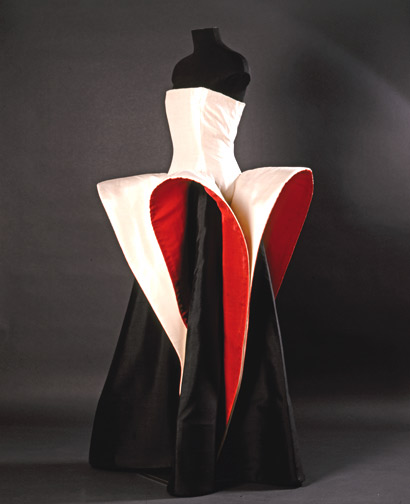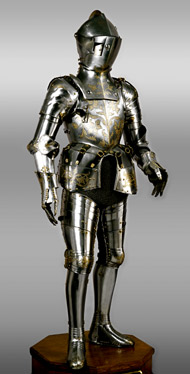The genesis of the Armour & Gown exhibition lies in another exhibition. In 1991, an unforgettable, indeed dazzling, tournament was staged at the Hofburg in Vienna under the title of Gowns as Armour. Armour from the Hofburg Collection of Arms and Armour, the world's greatest display of this exquisite form of cultural achievement, though now largely viewed as taboo, jousted with gowns designed by Roberto Capucci, a leading Italian couturier. This project is intended as homage to the Vienna presentation, but goes beyond it in dramatics and dimension. These exclusive exhibits – more than 60 suits of armour and 12 gowns as well as numerous separate parts such as helmets, breastplates, cuirasses, cuisses and greaves, halberds and lances fill the large hall and the entire gallery and stairs
Richly ornamented metal suits
Here, Jean Tinguely, kineticist and extraordinarily gifted amateur who conjured with waste materials and scrap metal, a self-proclaimed anarchist and closet militarist, encounters the golden age of this metier, the handicraft of armour-making. "Armourer" was the name for these masters and metal artists, who, from their forges in Augsburg and Nuremberg, Milan and Brescia, supplied the European armies and courts. The selection of armour from the world of chivalric culture that stretched from westernmost Europe through Turkey, India and Tibet to Japan may contain only objects from the Habsburg Empire and Switzerland, but it is an adequate reflection of a turbulent epoch of medieval history. Most of the suits of armour on display were made between 1485 and 1570 and come from the last two active medieval armouries in Europe, namely Graz in Styria, which borders on the territories of the Turkish invaders, and Solothurn. Lansquenets, "knaves" and hussars from the Graz collections are joined by a Solothurn "delegation" to evoke the battles of Morgarten, Sempach and Näfels. The transition from battlefield to tournament after 1500 during the reign of Emperor Maximilian I (1459-1519), "The Last Knight", is illustrated by decorated fluted suits of armour from Graz and, especially, by twelve exceptional examples of "tailored", richly ornamented metal suits for emperors, archdukes and landgraves from the Kunsthistorisches Museum in Vienna.
Capucci: gowns as armour
At this point the dialogue takes up with Roberto Capucci's frequently pleated, silken evening gowns of the 1980s. Born in Rome in 1930, the couturier was famous in the 1950s for creations that clothed beauties such as Esther Williams and Silvana Mangano; for a brief period in the early 1960s he worked with Christian Dior in Paris. Armour was one of his inspirations from an early stage – like these suits, each gown is a celebration of his craft as triumphant, artificial second skin. In these surroundings Eros meets Thanatos – the hollow, faceless bodies enchant while sending shivers down the spine; war and world stage, extinction and elevation parade hand in hand down the catwalk of history, of myths and illusion, of the blood-soaked earth and the wild dreams of fantasy. As homage to the Vienna exhibition of 1991, Roberto Capucci's gowns open and conclude our tour. Commentaries by two women artists, Niki de Saint Phalle and Eva Aeppli, elaborate this gloriously coloured, soft world of fabric, critically appraising the mad male world of power, politics and violence through the myth of Lysistrata on the one hand and The Widows on the other.
From Schlemmer to Madonna
Oskar Schlemmer's figures for his Triadic Ballet also act as "mediators" between metal and fabric. On the gallery, groups of works by Tinguely, Luginbühl and Spoerri parody military history in the telling of their own spellbinding phenomena. In particular the legendary Barbara Shoot in Berne in 1972 and the film they made together Un rêve plus long que la nuit are elements of a larger historical context that continues with Tinguely's Hannibal or Totentanz and on into the present with M.S. Bastian's Apocalypse comic. An excursion through the countless films of knights and examples from Metropolis to Star Wars and from Madonna to Heath Ledger of how the "armoured" body lives on conclude this rediscovery of treasures too long under lock and key or in the isolated safekeeping of specialists and fanatics.
Illustration: Anton Peffenhauser, Augsburg, 1571 Suit of armour for the joust, Charles II of Inner Austria Kunsthistorisches Museum, Wien, Hofjagd- und Rüstkammer © Photo: Kunsthistorisches Museum Wien
PUBLICATION:
A catalogue with a foreword by the curator of the exhibition, Guido Magnaguagno, and contributions by Christian Beaufort, Andreas Beyer, Silvia Ferino, Marco Leutenegger, Johannes Ramharter, C. Raman Schlemmer, Daniel Spoerri and Andres Pardey is published by Kehrer Verlag, Heidelberg (German edition, hard cover, approx. 200 pp., 200 col. ills.). The catalogue will be presented at the Art Breakfast at the Museum Tinguely, to be held at 10.00 a.m. on Sunday, 14 June 2009.
To see more illustrations, click on VERSION FRANCAISE at the top of this page
|









